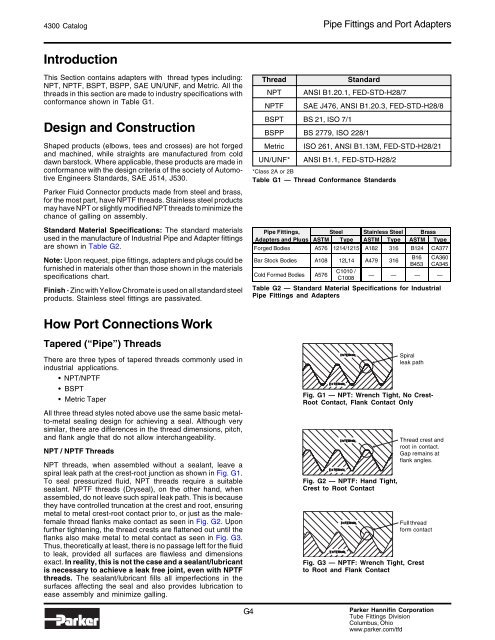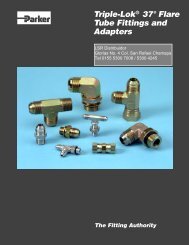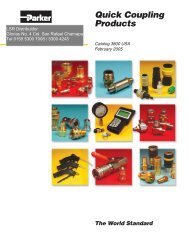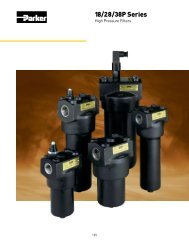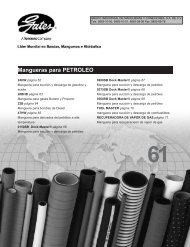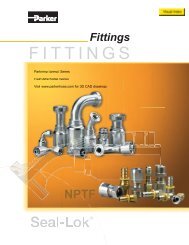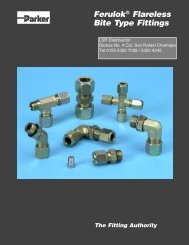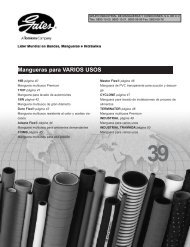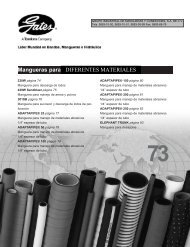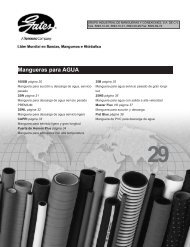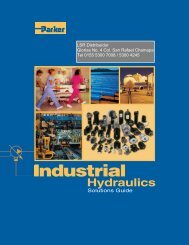Pipe Fittings & Port Adapters - LSR Distribuidor
Pipe Fittings & Port Adapters - LSR Distribuidor
Pipe Fittings & Port Adapters - LSR Distribuidor
You also want an ePaper? Increase the reach of your titles
YUMPU automatically turns print PDFs into web optimized ePapers that Google loves.
4300 Catalog <strong>Pipe</strong> <strong>Fittings</strong> and <strong>Port</strong> <strong>Adapters</strong>IntroductionThis Section contains adapters with thread types including:NPT, NPTF, BSPT, BSPP, SAE UN/UNF, and Metric. All thethreads in this section are made to industry specifications withconformance shown in Table G1.ThreadNPTNPTFStandardANSI B1.20.1, FED-STD-H28/7SAE J476, ANSI B1.20.3, FED-STD-H28/8Design and ConstructionShaped products (elbows, tees and crosses) are hot forgedand machined, while straights are manufactured from colddawn barstock. Where applicable, these products are made inconformance with the design criteria of the society of AutomotiveEngineers Standards, SAE J514, J530.Parker Fluid Connector products made from steel and brass,for the most part, have NPTF threads. Stainless steel productsmay have NPT or slightly modified NPT threads to minimize thechance of galling on assembly.Standard Material Specifications: The standard materialsused in the manufacture of Industrial <strong>Pipe</strong> and Adapter fittingsare shown in Table G2.Note: Upon request, pipe fittings, adapters and plugs could befurnished in materials other than those shown in the materialsspecifications chart.Finish - Zinc with Yellow Chromate is used on all standard steelproducts. Stainless steel fittings are passivated.BSPT BS 21, ISO 7/1BSPP BS 2779, ISO 228/1MetricUN/UNF*ISO 261, ANSI B1.13M, FED-STD-H28/21ANSI B1.1, FED-STD-H28/2*Class 2A or 2BTable G1 — Thread Conformance Standards<strong>Pipe</strong> <strong>Fittings</strong>, Steel Stainless Steel Brass<strong>Adapters</strong> and Plugs ASTM Type ASTM Type ASTM TypeForged Bodies A576 1214/1215 A182 316 B124 CA377Bar Stock Bodies A108 12L14 A479 316Cold Formed BodiesA576C1010 /C1008B16B453CA360CA345— — — —Table G2 — Standard Material Specifications for Industrial<strong>Pipe</strong> <strong>Fittings</strong> and <strong>Adapters</strong>How <strong>Port</strong> Connections WorkTapered (“<strong>Pipe</strong>”) ThreadsThere are three types of tapered threads commonly used inindustrial applications.• NPT/NPTF• BSPT• Metric TaperAll three thread styles noted above use the same basic metalto-metalsealing design for achieving a seal. Although verysimilar, there are differences in the thread dimensions, pitch,and flank angle that do not allow interchangeability.NPT / NPTF ThreadsNPT threads, when assembled without a sealant, leave aspiral leak path at the crest-root junction as shown in Fig. G1.To seal pressurized fluid, NPT threads require a suitablesealant. NPTF threads (Dryseal), on the other hand, whenassembled, do not leave such spiral leak path. This is becausethey have controlled truncation at the crest and root, ensuringmetal to metal crest-root contact prior to, or just as the malefemalethread flanks make contact as seen in Fig. G2. Uponfurther tightening, the thread crests are flattened out until theflanks also make metal to metal contact as seen in Fig. G3.Thus, theoretically at least, there is no passage left for the fluidto leak, provided all surfaces are flawless and dimensionsexact. In reality, this is not the case and a sealant/lubricantis necessary to achieve a leak free joint, even with NPTFthreads. The sealant/lubricant fills all imperfections in thesurfaces affecting the seal and also provides lubrication toease assembly and minimize galling.G4Spiralleak pathFig. G1 — NPT: Wrench Tight, No Crest-Root Contact, Flank Contact OnlyFig. G2 — NPTF: Hand Tight,Crest to Root ContactThread crest androot in contact.Gap remains atflank angles.Full threadform contactFig. G3 — NPTF: Wrench Tight, Crestto Root and Flank ContactParker Hannifin CorporationTube <strong>Fittings</strong> DivisionColumbus, Ohiowww.parker.com/tfd


